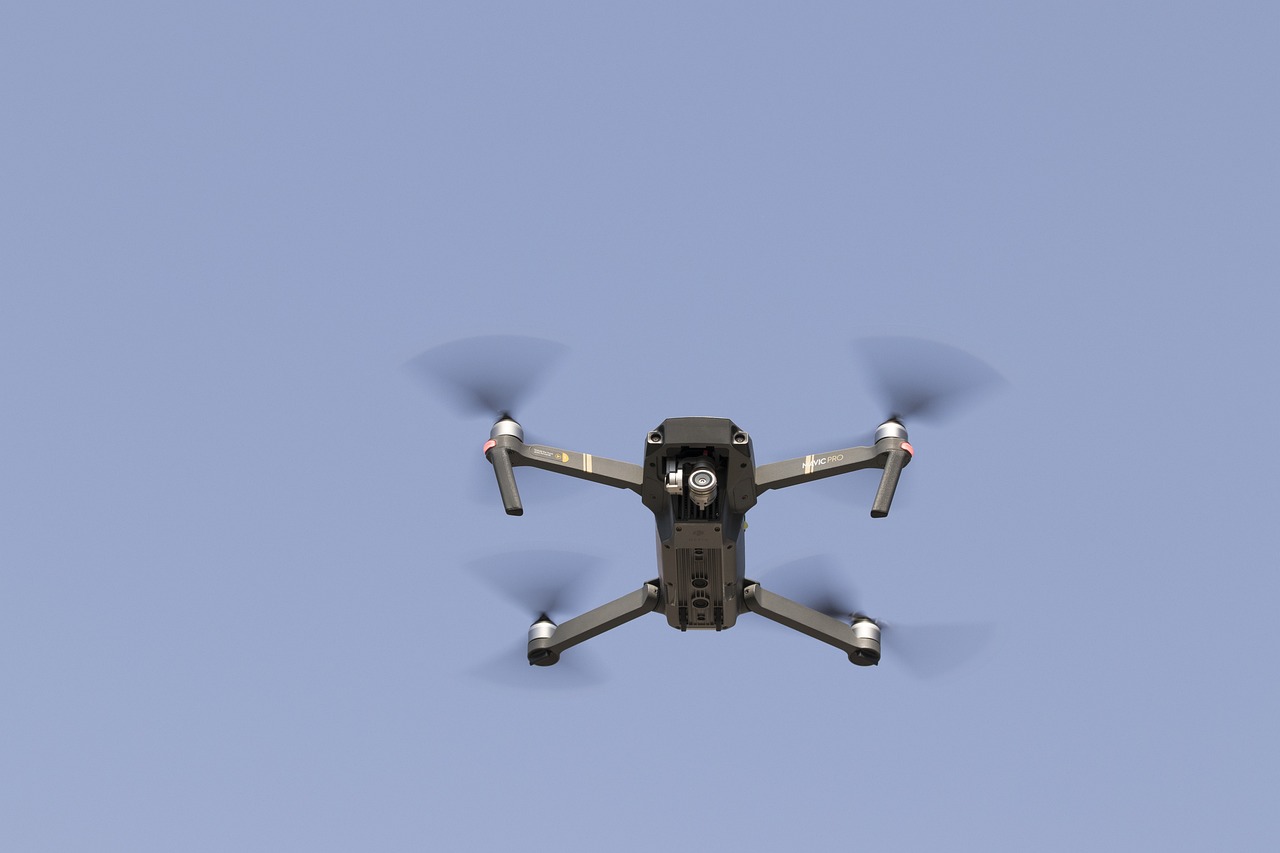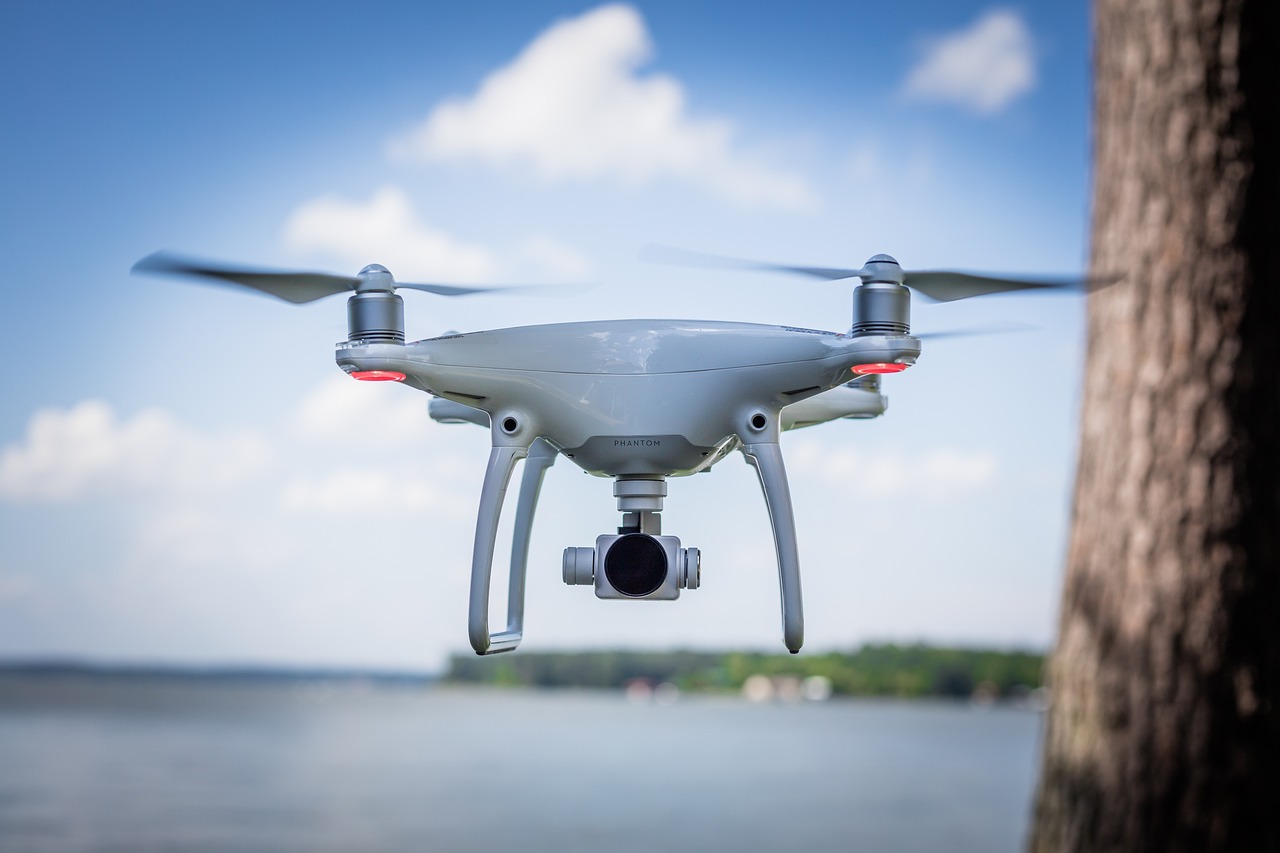AI-Driven Drone Jamming Technologies for Combat
In recent years, the battlefield has undergone a significant transformation, largely due to the rise of drones and unmanned aerial vehicles (UAVs). These flying machines have changed the way wars are fought, enabling real-time surveillance, precision strikes, and logistical support. However, with great power comes great responsibility, and the proliferation of drones has also led to the emergence of new threats. Enter AI-driven drone jamming technologies, a cutting-edge solution designed to counteract the growing menace of hostile drones.
Imagine a scene where a military operation is underway, and enemy drones are buzzing overhead, gathering intelligence or preparing to strike. This is where drone jamming technologies come into play, using artificial intelligence to disrupt these UAVs effectively. By employing sophisticated algorithms and real-time data analysis, these systems can identify, track, and neutralize enemy drones, ensuring the safety of ground troops and the success of missions.
At the heart of these technologies lies the integration of artificial intelligence, which enhances traditional jamming methods by making them smarter and more adaptive. AI allows for improved detection accuracy, faster response times, and the ability to adjust tactics on the fly, providing military forces with a crucial edge in combat scenarios. The dynamic nature of warfare demands such adaptability, and AI-driven jamming systems are rising to the challenge.
In essence, AI-driven drone jamming technologies represent a powerful tool in modern warfare, enabling forces to maintain air superiority and protect critical assets. As we delve deeper into this topic, we will explore the evolution of drone warfare, the mechanics of jamming technologies, and the challenges faced in implementing these systems. Buckle up, because the world of drone combat is as thrilling as it is complex!
Drone technology has revolutionized modern combat, shifting military strategies from traditional ground-based operations to aerial dominance. In the past, air power was primarily reserved for manned aircraft, but the introduction of UAVs has democratized the skies. These unmanned vehicles can perform a variety of roles, from reconnaissance to targeted strikes, all while minimizing risks to human life.
As military forces increasingly rely on drones, the need for countermeasures has become paramount. The ability to jam enemy drones is no longer just a tactical advantage; it’s a necessity. This evolution in warfare has prompted the development of sophisticated jamming technologies that leverage AI to enhance effectiveness and adaptability.
Drone jamming technologies are designed to disrupt the communication and navigation systems of UAVs, rendering them ineffective in carrying out their missions. These systems typically consist of several components, including signal generators, antennas, and advanced processing units that work in harmony to identify and neutralize threats.
At their core, jamming technologies operate on the principle of interference. By emitting signals that overpower the frequencies used by drones, these systems can effectively disrupt their operations. This can lead to various outcomes, such as forcing the drone to land, losing its way, or even crashing. The effectiveness of jamming technologies hinges on their ability to adapt to different types of drones and their operational environments.
There are several jamming techniques employed to counter drones, each with its own strengths and weaknesses:
- GPS Jamming: Disrupts the GPS signals that drones rely on for navigation.
- RF Jamming: Interferes with the radio frequencies used for communication between the drone and its operator.
- Spoofing: Sends false signals to the drone, misleading it about its position or commands.
GPS jamming is one of the most common techniques used against drones. By emitting signals on the same frequency as GPS, jammers can effectively blind a drone, preventing it from determining its location. This can lead to erratic behavior, as the drone may attempt to return to its last known position or hover aimlessly.
RF jamming operates on a similar principle, targeting the communication signals between the drone and its operator. By overwhelming these frequencies, jammers can disrupt command signals, causing the drone to lose control. Recent technological advancements have improved the range and accuracy of RF jamming, making it a formidable tool in combat scenarios.
Artificial intelligence plays a pivotal role in modern jamming systems. By analyzing data in real-time, AI algorithms can identify drone patterns, predict their movements, and adjust jamming tactics accordingly. This level of adaptability is crucial in fast-paced combat environments, where every second counts.
Despite their effectiveness, deploying jamming technologies comes with its own set of challenges. Technical issues, such as signal interference and the need for precise targeting, can complicate operations. Additionally, there are ethical and legal concerns surrounding the use of such technologies, particularly regarding potential collateral damage and civilian safety.
The use of jamming technologies in warfare raises significant legal and ethical questions. International laws govern the use of force and the protection of civilians, and military forces must navigate these frameworks carefully. The potential for unintended consequences, such as disrupting civilian drones or communication systems, adds another layer of complexity to the deployment of jamming technologies.
As jamming technologies evolve, so too do the countermeasures employed by adversaries. Some drones are being designed with enhanced resilience to jamming signals, while others utilize alternative navigation systems that are less susceptible to interference. This ongoing arms race between jammers and drones highlights the dynamic nature of modern warfare.
- What are drone jamming technologies? Drone jamming technologies are systems designed to disrupt the communication and navigation of UAVs, preventing them from carrying out their missions.
- How does AI enhance jamming systems? AI improves detection accuracy, response times, and adaptability, allowing jamming systems to effectively counter a wide range of drone threats.
- Are there legal implications to using jamming technologies? Yes, there are legal and ethical considerations, including international laws that govern the use of force and the protection of civilians in conflict zones.

The Evolution of Drone Warfare
The landscape of modern warfare has undergone a dramatic transformation over the past few decades, largely driven by the **advent of drone technology**. These unmanned aerial vehicles (UAVs) have revolutionized how military operations are conducted, shifting the paradigm from traditional combat to a more technology-driven approach. Imagine a battlefield where soldiers can operate from thousands of miles away, relying on real-time data and aerial surveillance provided by drones. This is not science fiction; it is the reality of contemporary warfare.
Initially, drones were primarily used for **reconnaissance and surveillance**. Their ability to capture high-resolution images and gather intelligence without putting human lives at risk was a game changer. As military forces recognized the potential of UAVs, the focus shifted towards offensive capabilities. Today, drones are equipped with precision-guided munitions, allowing for targeted strikes with minimal collateral damage. This evolution reflects a broader trend in military strategy—**the move towards remote warfare**.
As we delve deeper into the evolution of drone warfare, it is essential to consider the following key milestones:
- Early Reconnaissance: The use of drones for intelligence gathering began during the Cold War, paving the way for future developments.
- Combat Drones: The introduction of armed drones like the Predator and Reaper marked a significant shift, enabling direct engagement with enemy forces.
- AI Integration: Recent advancements in artificial intelligence have further enhanced the capabilities of drones, allowing for autonomous operations and improved decision-making.
Moreover, the **strategic implications** of drone warfare cannot be overstated. With the ability to conduct operations without risking personnel, military forces can engage in missions that would otherwise be deemed too dangerous. This has led to a **new era of asymmetrical warfare**, where smaller, less equipped forces can challenge more powerful adversaries through the use of drones. The democratization of drone technology has made it accessible to various state and non-state actors, complicating the global security landscape.
However, this evolution has not come without its challenges. The reliance on drone technology raises questions about **accountability and ethics**. As drones become more autonomous, the line between human decision-making and machine execution blurs, leading to potential moral dilemmas in combat scenarios. Additionally, the proliferation of drone technology among various factions poses significant risks, as hostile entities could exploit these capabilities against established military powers.
In conclusion, the evolution of drone warfare represents a profound shift in military strategy and tactics. As technology continues to advance, it is crucial for military forces and policymakers to navigate the complexities of this new battlefield landscape thoughtfully. The future of warfare is undoubtedly intertwined with the capabilities of drones, making it imperative to understand their implications fully.
- What are the primary uses of drones in warfare?
Drones are primarily used for surveillance, reconnaissance, and targeted strikes. They provide real-time intelligence and can engage enemy forces without risking human lives. - How have drones changed military strategies?
Drones have shifted military strategies towards remote warfare, allowing forces to conduct operations from a distance and minimizing the risks associated with traditional combat. - What ethical concerns are associated with drone warfare?
Ethical concerns include accountability for actions taken by drones, the potential for civilian casualties, and the moral implications of autonomous decision-making in combat.

Understanding Drone Jamming Technologies
In the rapidly evolving landscape of modern warfare, the emergence of drone jamming technologies has become a pivotal strategy for military forces around the globe. These technologies are designed to disrupt the communication and navigation systems of unmanned aerial vehicles (UAVs), effectively neutralizing potential threats posed by enemy drones. But how exactly do these jamming technologies work? Let’s dive deeper into the mechanics, components, and principles that underpin these sophisticated systems.
At its core, drone jamming technology operates by emitting signals that interfere with the frequencies used by drones for communication and navigation. This interference can take several forms, including GPS jamming, RF jamming, and more advanced techniques like spoofing. Each method has its unique approach to disrupting drone operations, and understanding these differences is crucial for comprehending their effectiveness in combat scenarios.
One of the primary components of jamming systems is the jamming transmitter, which generates the disruptive signals. These transmitters can be stationary or portable, allowing for flexibility in deployment. Additionally, modern jamming systems often incorporate AI algorithms to enhance their performance. By analyzing the drone's communication patterns and adapting in real-time, AI-driven jamming systems can significantly improve their effectiveness against enemy drones.
Moreover, the principles behind drone jamming are rooted in the understanding of how drones communicate. Drones typically rely on a combination of GPS signals for navigation and radio frequencies for command and control. By targeting these specific frequencies, jamming systems can effectively mislead or incapacitate the drone's operational capabilities. For instance, when a drone's GPS signal is jammed, it may lose its ability to navigate properly, leading to erratic behavior or even a crash.
To give you a clearer picture, let’s break down the types of jamming techniques and their applications:
| Jamming Technique | Description | Applications |
|---|---|---|
| GPS Jamming | Disrupts the satellite signals used for navigation. | Effective against drones relying on GPS for positioning. |
| RF Jamming | Interferes with the radio frequencies used for communication. | Can prevent remote control of drones. |
| Spoofing | Tricks the drone into believing it is receiving valid signals. | Can redirect drones or cause them to land in unintended locations. |
In conclusion, understanding drone jamming technologies is essential for grasping their role in contemporary warfare. As military strategies continue to evolve, the effectiveness of these jamming systems will undoubtedly play a crucial role in shaping the battlefield. With the integration of artificial intelligence, we are witnessing a new era of combat where the ability to disrupt enemy UAVs can mean the difference between victory and defeat.
- What is drone jamming? Drone jamming refers to the use of technologies designed to disrupt the communication and navigation systems of drones.
- How does GPS jamming work? GPS jamming works by emitting signals that interfere with the GPS signals received by drones, causing them to lose their navigational capabilities.
- Are there ethical concerns with jamming technologies? Yes, there are legal and ethical implications, especially regarding collateral damage and the potential for unintended consequences in combat zones.
- Can drones defend against jamming? Yes, advancements in drone technology are leading to improved resilience against jamming, such as alternative navigation systems and enhanced communication protocols.

Types of Jamming Techniques
When it comes to neutralizing the threat posed by drones, understanding the various jamming techniques is crucial. These methods are not just about creating noise; they are sophisticated strategies designed to disrupt the operational capabilities of unmanned aerial vehicles (UAVs). Let's dive into the world of jamming and explore the primary techniques employed in combat scenarios.
One of the most well-known techniques is GPS jamming. This method targets the Global Positioning System signals that drones rely on for navigation. By emitting signals that overpower the legitimate GPS signals, jammers can effectively mislead or completely disable a drone's ability to determine its position. Imagine trying to navigate through a city without a map or GPS—this is the predicament a drone faces when subjected to GPS jamming.
Another significant technique is RF jamming, which involves disrupting the radio frequency communications between the drone and its operator. Drones typically use specific radio frequencies to receive commands and transmit data. By flooding these frequencies with noise or stronger signals, RF jamming can sever the connection, rendering the drone uncontrollable. This is akin to a phone call being interrupted by static; the communication becomes garbled and ineffective.
Additionally, there is a technique known as spoofing. Unlike traditional jamming, which aims to disrupt signals, spoofing involves sending false signals to the drone, tricking it into thinking it is receiving legitimate commands. This can lead the drone to follow erroneous instructions, potentially causing it to crash or fly off course. Spoofing is like a magician performing a trick, where the audience is led to believe in something that isn't real.
To summarize, the primary jamming techniques can be categorized as follows:
| Technique | Description | Effectiveness |
|---|---|---|
| GPS Jamming | Disrupts GPS signals to mislead or disable drone navigation. | Highly effective against drones reliant on GPS. |
| RF Jamming | Interferes with radio frequency communications between the drone and operator. | Very effective, especially in close-range scenarios. |
| Spoofing | Sends false signals to manipulate the drone's behavior. | Effective in causing confusion and misdirection. |
Each of these jamming techniques plays a vital role in modern warfare, offering military forces the ability to counteract the growing prevalence of drones on the battlefield. However, it's essential to understand that with great power comes great responsibility. The effectiveness of these technologies must be balanced with ethical considerations and the potential for unintended consequences.
- What is the main purpose of drone jamming technologies?
Drone jamming technologies are designed to disrupt the operational capabilities of drones, preventing them from carrying out their intended missions. - Are jamming techniques legal in combat?
The legality of jamming techniques varies by country and is subject to international laws governing warfare. It's crucial for military forces to adhere to these regulations. - Can drones defend against jamming?
Yes, some drones are equipped with countermeasures to mitigate the effects of jamming, such as alternative navigation systems and improved signal resilience.

GPS Jamming
is a critical aspect of modern warfare, where the ability to disrupt an enemy's navigation systems can turn the tide of a battle. Imagine being in a high-stakes game of chess, where each move can either lead to victory or defeat. In this scenario, GPS jamming acts like a clever strategy that can obscure the opponent's view of the board, making it nearly impossible for them to execute their plans effectively. By emitting signals that interfere with GPS satellites, jamming technologies can render drones—often reliant on precise location data—blind and vulnerable.
The mechanics behind GPS jamming are relatively straightforward yet highly effective. At its core, GPS jamming involves broadcasting signals on the same frequency as GPS satellites, creating a "noise" that overwhelms the signals intended for the drones. This can lead to a range of outcomes, from simple navigation errors to complete loss of control. Drones that depend on GPS for their flight paths may find themselves drifting off course or even crashing, thus neutralizing a significant threat on the battlefield.
However, the effectiveness of GPS jamming isn't without its challenges. As technology evolves, so too do the countermeasures employed by drone manufacturers. Many modern drones are equipped with anti-jamming technologies that can detect interference and switch to alternative navigation methods, such as inertial navigation systems or visual positioning systems. This cat-and-mouse game between jammers and drone manufacturers highlights the ongoing arms race in aerial warfare.
To give you a better understanding of the impact of GPS jamming, consider the following table that outlines some of the key features and challenges associated with this technology:
| Feature | Description |
|---|---|
| Signal Interference | Disrupts communication between drones and GPS satellites. |
| Operational Range | Varies depending on the power of the jamming device and the environment. |
| Countermeasures | Advanced drones may use inertial navigation or visual systems to mitigate jamming effects. |
| Legal Considerations | Use of jamming technologies is subject to international laws and regulations. |
In summary, GPS jamming is a formidable tool in the arsenal of modern military strategies. It not only disrupts enemy operations but also forces a reevaluation of how drone technology is developed and deployed. As we look to the future, the ongoing advancements in both jamming technologies and countermeasures will undoubtedly shape the landscape of aerial combat in unprecedented ways.
- What is GPS jamming? GPS jamming is the process of disrupting the signals between GPS satellites and ground-based receivers, which can affect the navigation capabilities of drones and other GPS-dependent systems.
- How does GPS jamming work? It works by broadcasting signals on the same frequency as GPS satellites, creating interference that can confuse or blind the receiving devices.
- What are the countermeasures against GPS jamming? Countermeasures include using alternative navigation systems like inertial navigation or visual positioning, which do not rely solely on GPS signals.
- Are there legal issues surrounding GPS jamming? Yes, the use of jamming technologies is regulated by international laws, and unauthorized jamming can have serious legal consequences.

RF Jamming
Radio Frequency (RF) jamming is a pivotal technology in the realm of modern warfare, specifically designed to disrupt the communication and control of unmanned aerial vehicles (UAVs). Imagine a world where the skies are filled with drones, each buzzing with intelligence and surveillance capabilities. Now, picture a powerful force that can effectively silence these buzzing machines, rendering them useless in the heat of battle. This is precisely what RF jamming aims to achieve. By emitting signals that interfere with the frequencies used by drones, RF jamming can create chaos in enemy operations, turning their sophisticated technology into mere toys that can no longer function.
The effectiveness of RF jamming lies in its ability to target the specific frequencies that drones rely on for communication and navigation. Drones typically operate on a range of frequencies, which can be susceptible to interference. When an RF jammer is deployed, it sends out a stronger signal on the same frequency, effectively drowning out the drone's communication. This can lead to loss of control, navigation failures, and ultimately, the incapacitation of the drone. It’s like trying to hear a whisper in a crowded room—if someone starts shouting, all you’ll hear is the noise, and the message gets lost.
One of the most significant advantages of RF jamming is its versatility. Jamming systems can be designed to target specific drones or a broad spectrum of frequencies, making them adaptable to various combat scenarios. However, the effectiveness of RF jamming is not without its challenges. As drone technology evolves, so do the countermeasures. Many modern drones are equipped with advanced resilience features, including frequency hopping, which allows them to rapidly switch frequencies to evade jamming attempts. This is akin to a skilled dancer who can effortlessly change rhythm to avoid being stepped on in a crowded dance floor.
Furthermore, the deployment of RF jamming technologies comes with its own set of challenges. For instance, the unintended disruption of civilian communications can pose ethical and legal dilemmas. In urban combat zones, where civilian and military operations often intertwine, the use of RF jamming must be approached with caution. The potential for collateral damage is a significant concern, as jamming signals could interfere with emergency services or civilian drones used for legitimate purposes.
To sum it up, RF jamming stands as a formidable tool in the arsenal of modern warfare, capable of turning the tide by crippling enemy drones. However, it is essential for military strategists to weigh the benefits against the potential risks and ethical implications. As technology continues to advance, the dance between jamming technologies and drone resilience will likely intensify, prompting ongoing innovation and adaptation in the field.
- What is RF jamming? RF jamming refers to the intentional disruption of radio communications by emitting signals that interfere with the frequencies used by drones.
- How does RF jamming affect drone operations? It can lead to loss of control and navigation failures, rendering the drone inoperable.
- Are there any ethical concerns with RF jamming? Yes, there are significant ethical and legal implications, especially regarding the potential disruption of civilian communications.
- What are the countermeasures against RF jamming? Modern drones may employ frequency hopping and other resilience features to evade jamming attempts.

AI Integration in Jamming Systems
The integration of Artificial Intelligence (AI) into drone jamming technologies represents a monumental leap in military strategy and effectiveness. Imagine a battlefield where drones are not just tools for surveillance or attack, but also threats that can be neutralized with incredible precision and speed. AI enhances jamming systems by providing them with the ability to analyze vast amounts of data in real-time, allowing for quick responses to incoming threats. This is akin to having a highly skilled chess player who can anticipate moves several steps ahead, making it possible to counteract enemy drones before they can execute their mission.
One of the most significant advantages of AI in jamming systems is its capability to improve detection accuracy. Traditional jamming technologies often rely on pre-set parameters and static algorithms, which can be easily outmaneuvered by adaptive drone technologies. However, AI algorithms can learn from their environment, adapting to changes and refining their jamming techniques based on real-time data. For instance, if a drone employs a new communication protocol, an AI-driven jamming system can quickly analyze this protocol and modify its approach, ensuring continued effectiveness against evolving threats.
Moreover, AI enhances response times in combat scenarios. In a world where seconds can mean the difference between success and failure, the ability of AI to process information and execute jamming actions almost instantaneously is invaluable. This rapid decision-making process allows military operators to focus on broader strategies while the AI handles the minutiae of jamming enemy drones. Picture a scenario where a swarm of enemy drones is approaching a military base; an AI-integrated jamming system can identify the drones, assess their communication methods, and deploy the appropriate jamming techniques all within moments, effectively neutralizing the threat before it materializes.
Another fascinating aspect of AI integration is its adaptability. In dynamic combat environments, conditions can change rapidly. AI systems can continuously learn from each encounter, refining their algorithms to improve future performance. This adaptability is crucial, as adversaries may employ counter-jamming techniques or develop new drone technologies. By leveraging machine learning, AI can analyze past engagements, recognize patterns, and predict future actions, ensuring that jamming systems remain a step ahead in the ongoing cat-and-mouse game of modern warfare.
Furthermore, AI can facilitate multi-target jamming. Traditional jamming systems often struggle to effectively jam multiple drones simultaneously, especially if they are using different frequencies or communication methods. AI can manage multiple jamming signals across various frequencies, ensuring that all potential threats are neutralized without overwhelming the system. This capability is akin to a conductor leading an orchestra, ensuring that every instrument plays in harmony to create a unified outcome against the threat of enemy drones.
In conclusion, the integration of AI into drone jamming technologies is reshaping the landscape of modern warfare. By enhancing detection accuracy, improving response times, and providing adaptability in dynamic environments, AI-driven jamming systems are becoming indispensable tools for military forces. As we continue to witness technological advancements, the future of combat will undoubtedly rely heavily on these intelligent systems, transforming the way we approach aerial threats.
- What is AI integration in jamming systems?
AI integration in jamming systems refers to the use of artificial intelligence to enhance the effectiveness and efficiency of technologies designed to disrupt drone communications and navigation. - How does AI improve detection accuracy?
AI improves detection accuracy by analyzing real-time data and adapting to new threats, allowing for more precise identification and neutralization of enemy drones. - Can AI jamming systems handle multiple drones at once?
Yes, AI can manage multiple jamming signals across various frequencies, effectively neutralizing several drones simultaneously. - What are the benefits of using AI in military operations?
Benefits include faster response times, improved adaptability, and enhanced effectiveness in countering evolving drone technologies.

Challenges in Implementing Jamming Technologies
As the battlefield evolves with the integration of advanced technologies, jamming technologies have emerged as a crucial countermeasure against drone warfare. However, implementing these systems is no walk in the park. There are a multitude of challenges that military forces face when deploying jamming technologies in combat scenarios. Let's dive into some of the most pressing issues that can hinder their effectiveness.
One of the primary challenges is the technical complexity of jamming systems. These technologies must be finely tuned to effectively disrupt drone operations without causing unintended interference with other essential communication systems. The balance between effectiveness and precision is delicate; too much interference can lead to collateral damage, while too little may fail to neutralize the threat. This complexity often requires highly trained personnel and advanced equipment, which can be costly and time-consuming to procure and maintain.
Another significant hurdle is the legal and ethical implications associated with jamming technologies. International laws and military regulations govern the use of such systems, and navigating these legal frameworks can be a daunting task. For instance, the use of jamming devices may inadvertently disrupt civilian communications, leading to ethical dilemmas. Military forces must carefully consider the potential fallout from their actions, as public opinion can sway dramatically based on perceived misuse of technology. The potential for collateral damage is a serious concern, as jamming could affect not just enemy drones but also civilian aircraft and ground communications.
Moreover, the adaptive nature of adversaries poses a significant challenge. As jamming technologies evolve, so too do the countermeasures employed by opposing forces. This creates a continuous cycle of technological advancement where both sides strive to outsmart each other. For instance, some drones are now being equipped with advanced navigation systems that can bypass traditional jamming techniques, making it essential for military forces to stay one step ahead. This arms race not only drives up costs but also complicates the strategic landscape of modern warfare.
Lastly, the operational environment plays a crucial role in the effectiveness of jamming technologies. Factors such as terrain, weather conditions, and the density of electronic signals in a given area can all impact jamming performance. For example, urban environments with high levels of electronic activity can create a chaotic backdrop, making it difficult for jamming systems to distinguish between friendly and enemy signals. This can lead to misfires and unintended consequences, further complicating military operations.
In summary, while jamming technologies hold significant promise in combating drone threats, their implementation is fraught with challenges. From technical complexities and legal implications to adversarial adaptations and operational environments, military forces must navigate a complex web of factors to effectively deploy these systems. As the landscape of warfare continues to change, addressing these challenges will be critical for maintaining a tactical advantage in the skies.
- What are jamming technologies? Jamming technologies are systems designed to disrupt the communication and navigation signals of drones, rendering them ineffective.
- Why are there legal concerns regarding jamming technologies? The use of jamming can interfere with civilian communications and air traffic, raising ethical and legal issues under international law.
- How do adversaries counter jamming technologies? Adversaries may employ advanced navigation systems or develop counter-jamming technologies to mitigate the effects of jamming.
- What role does AI play in jamming technologies? AI enhances jamming systems by improving detection accuracy, response times, and adaptability in dynamic combat environments.

Legal and Ethical Implications
As the battlefield evolves with the integration of AI-driven drone jamming technologies, the surrounding their use become increasingly complex. On one hand, these technologies offer military forces the ability to disrupt enemy operations and protect assets, but on the other hand, they raise significant questions regarding compliance with international law and the potential for unintended consequences.
International humanitarian law (IHL) governs the conduct of armed conflict and seeks to limit its effects. The use of jamming technologies must adhere to principles such as distinction, proportionality, and necessity. Distinction requires that combatants distinguish between military targets and civilians, while proportionality aims to ensure that any collateral damage is not excessive in relation to the anticipated military advantage. The challenge lies in ensuring that jamming operations do not inadvertently disrupt civilian communications or navigation systems, potentially leading to harm to non-combatants.
Moreover, the ethical dilemmas associated with deploying these technologies cannot be overlooked. For instance, the potential for collateral damage raises critical questions about the moral responsibility of military commanders. If a jamming operation results in civilian casualties, who is held accountable? This dilemma is heightened in urban warfare scenarios, where the lines between combatants and civilians are often blurred.
Another layer of complexity is added by the rapid advancement of drone technology, which can outpace existing legal frameworks. Many countries are still grappling with how to regulate the use of drones and jamming technologies effectively. International treaties and agreements, such as the Convention on Certain Conventional Weapons (CCW), may need to be revisited and revised to address these modern challenges adequately.
To illustrate the legal landscape, consider the following table that summarizes key legal considerations for military forces employing jamming technologies:
| Legal Consideration | Description |
|---|---|
| Distinction | Must differentiate between combatants and civilians to avoid targeting non-combatants. |
| Proportionality | Collateral damage must not be excessive compared to the military advantage gained. |
| Necessity | Jamming must be necessary to achieve a legitimate military objective. |
| Accountability | Clear lines of accountability must be established for any collateral damage caused. |
In conclusion, the deployment of AI-driven drone jamming technologies in combat scenarios presents a double-edged sword. While they enhance military effectiveness, they also pose significant legal and ethical challenges that must be carefully navigated. Military forces must not only be aware of the technical capabilities of these systems but also the broader implications of their use in warfare.
- What are the main legal frameworks governing drone jamming technologies?
The primary legal frameworks include international humanitarian law, which emphasizes principles such as distinction and proportionality.
- How can military forces ensure compliance with ethical standards when using jamming technologies?
By establishing clear rules of engagement and accountability measures, military forces can navigate the ethical complexities involved in jamming operations.
- What are the potential consequences of collateral damage from jamming technologies?
Collateral damage can lead to civilian casualties, legal repercussions, and damage to a military's reputation, complicating future operations.

Countermeasures Against Jamming
As the battlefield evolves, so do the tactics employed by both sides. When it comes to drone warfare, the introduction of jamming technologies has created a significant tactical advantage for forces equipped with these systems. However, adversaries are not sitting idle; they are actively developing countermeasures to mitigate the effects of jamming. Understanding these countermeasures is crucial for grasping the full scope of modern combat dynamics.
One of the primary strategies against jamming is the development of resilient communication systems. These systems are designed to maintain a stable connection with drones even when jamming attempts are underway. For instance, some drones now utilize frequency hopping techniques, which involve rapidly switching between different frequencies to avoid detection and disruption. This method makes it significantly more difficult for jamming technologies to keep up and effectively target the drone's communications.
Moreover, advancements in alternative navigation systems are also crucial. While GPS is often the primary means of navigation for drones, the reliance on a single system can be a vulnerability. By integrating inertial navigation systems (INS) or visual odometry, drones can continue to operate even when GPS signals are compromised. These systems allow drones to navigate using internal sensors or visual cues, providing a backup that can be life-saving in combat scenarios.
Another fascinating approach involves the use of artificial intelligence to enhance drone resilience. AI can analyze the electromagnetic environment in real-time, allowing drones to detect jamming signals and adjust their operational parameters accordingly. This could mean changing flight paths, switching frequencies, or even temporarily shutting down non-essential systems to conserve power and maintain core functions. The adaptability provided by AI not only improves the survivability of drones but also allows for more strategic responses to jamming attempts.
Additionally, some military forces are exploring the concept of swarm technology. By deploying multiple drones that operate collaboratively, they can create a networked system that is harder to jam. If one drone loses communication due to jamming, the others can still relay information and maintain mission objectives. This collective approach can overwhelm jamming technologies, making it a promising direction for future military operations.
However, it’s essential to recognize that the arms race between jamming technologies and countermeasures is ongoing. As jamming systems become more sophisticated, countermeasures must evolve correspondingly. The challenge lies not only in technological advancements but also in the ethical considerations surrounding their use. Military forces must navigate the complex legal landscape while ensuring that their strategies do not lead to unintended consequences, such as collateral damage or violations of international laws.
In conclusion, the countermeasures against drone jamming are as varied as the technologies designed to disrupt them. From resilient communication systems and alternative navigation methods to AI enhancements and swarm tactics, the landscape of modern warfare continues to shift. As we look ahead, the interplay between offensive jamming technologies and defensive countermeasures will undoubtedly shape the future of combat in profound ways.
- What are the most common countermeasures against drone jamming?
Common countermeasures include resilient communication systems, alternative navigation technologies, and the use of artificial intelligence to adapt to jamming attempts. - How does frequency hopping work?
Frequency hopping is a technique where drones rapidly switch between different frequencies, making it difficult for jamming systems to target them effectively. - Can drones operate without GPS?
Yes, drones can utilize alternative navigation systems such as inertial navigation or visual odometry to operate independently of GPS signals. - What role does AI play in countering jamming?
AI enhances drones' ability to detect jamming signals in real-time, allowing them to adjust their operations and maintain functionality despite disruptions.
Frequently Asked Questions
- What are drone jamming technologies?
Drone jamming technologies are systems designed to disrupt the communication and navigation signals of unmanned aerial vehicles (UAVs). By interfering with the signals that drones rely on, these technologies can effectively neutralize threats posed by hostile drones in combat scenarios.
- How does AI enhance drone jamming systems?
AI enhances drone jamming systems by improving their detection accuracy and response times. With machine learning algorithms, these systems can adapt to changing environments and tactics employed by enemy drones, making them more effective in dynamic combat situations.
- What types of jamming techniques are commonly used?
Common jamming techniques include GPS jamming, RF jamming, and spoofing. Each technique targets specific aspects of drone operation, such as navigation and communication, to incapacitate the drone's functionality.
- What are the legal implications of using jamming technologies?
The use of jamming technologies in warfare raises several legal implications, including compliance with international laws and regulations. Military forces must navigate complex legal frameworks to ensure that their jamming activities do not violate rights or cause unintended harm.
- Can drones have countermeasures against jamming?
Yes, drones can be equipped with countermeasures to combat jamming. These may include alternative navigation systems, enhanced signal resilience, and other technological advancements that allow drones to maintain functionality even when subjected to jamming attempts.
- What are the ethical concerns surrounding drone jamming?
Ethical concerns regarding drone jamming include the potential for collateral damage, unintended consequences, and the moral implications of disrupting enemy operations. Military forces must carefully consider these factors when deploying jamming technologies in combat.



















